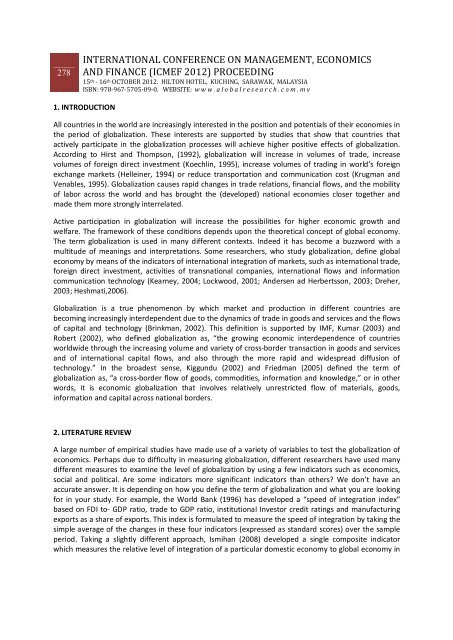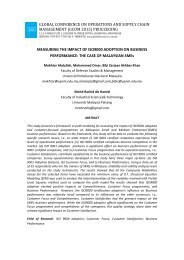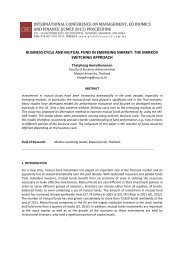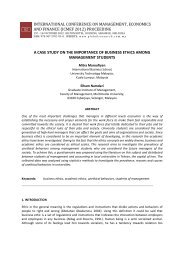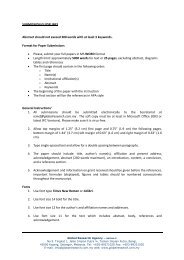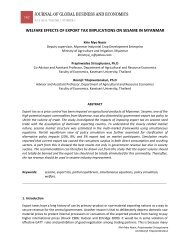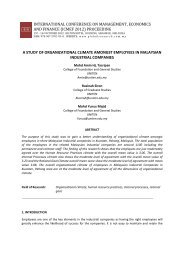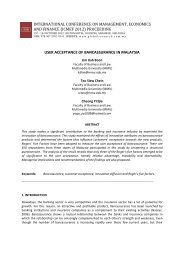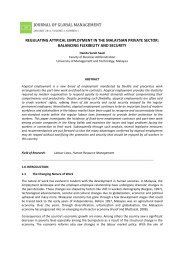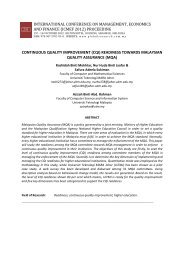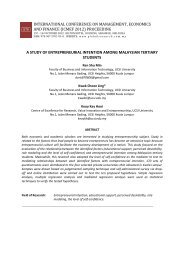(icmef 2012) proceeding developing standardized economic drivers f
(icmef 2012) proceeding developing standardized economic drivers f
(icmef 2012) proceeding developing standardized economic drivers f
Create successful ePaper yourself
Turn your PDF publications into a flip-book with our unique Google optimized e-Paper software.
278<br />
INTERNATIONAL CONFERENCE ON MANAGEMENT, ECONOMICS<br />
AND FINANCE (ICMEF <strong>2012</strong>) PROCEEDING<br />
15 th - 16 th OCTOBER <strong>2012</strong>. HILTON HOTEL, KUCHING, SARAWAK, MALAYSIA<br />
ISBN: 978-967-5705-09-0. WEBSITE: w w w . g l o b a l r e s e a r c h . c o m . m y<br />
1. INTRODUCTION<br />
All countries in the world are increasingly interested in the position and potentials of their economies in<br />
the period of globalization. These interests are supported by studies that show that countries that<br />
actively participate in the globalization processes will achieve higher positive effects of globalization.<br />
According to Hirst and Thompson, (1992), globalization will increase in volumes of trade, increase<br />
volumes of foreign direct investment (Koechlin, 1995), increase volumes of trading in world’s foreign<br />
exchange markets (Helleiner, 1994) or reduce transportation and communication cost (Krugman and<br />
Venables, 1995). Globalization causes rapid changes in trade relations, financial flows, and the mobility<br />
of labor across the world and has brought the (developed) national economies closer together and<br />
made them more strongly interrelated.<br />
Active participation in globalization will increase the possibilities for higher <strong>economic</strong> growth and<br />
welfare. The framework of these conditions depends upon the theoretical concept of global economy.<br />
The term globalization is used in many different contexts. Indeed it has become a buzzword with a<br />
multitude of meanings and interpretations. Some researchers, who study globalization, define global<br />
economy by means of the indicators of international integration of markets, such as international trade,<br />
foreign direct investment, activities of transnational companies, international flows and information<br />
communication technology (Kearney, 2004; Lockwood, 2001; Andersen ad Herbertsson, 2003; Dreher,<br />
2003; Heshmati,2006).<br />
Globalization is a true phenomenon by which market and production in different countries are<br />
becoming increasingly interdependent due to the dynamics of trade in goods and services and the flows<br />
of capital and technology (Brinkman, 2002). This definition is supported by IMF, Kumar (2003) and<br />
Robert (2002), who defined globalization as, “the growing <strong>economic</strong> interdependence of countries<br />
worldwide through the increasing volume and variety of cross-border transaction in goods and services<br />
and of international capital flows, and also through the more rapid and widespread diffusion of<br />
technology.” In the broadest sense, Kiggundu (2002) and Friedman (2005) defined the term of<br />
globalization as, “a cross-border flow of goods, commodities, information and knowledge,” or in other<br />
words, it is <strong>economic</strong> globalization that involves relatively unrestricted flow of materials, goods,<br />
information and capital across national borders.<br />
2. LITERATURE REVIEW<br />
A large number of empirical studies have made use of a variety of variables to test the globalization of<br />
<strong>economic</strong>s. Perhaps due to difficulty in measuring globalization, different researchers have used many<br />
different measures to examine the level of globalization by using a few indicators such as <strong>economic</strong>s,<br />
social and political. Are some indicators more significant indicators than others? We don’t have an<br />
accurate answer. It is depending on how you define the term of globalization and what you are looking<br />
for in your study. For example, the World Bank (1996) has developed a “speed of integration index”<br />
based on FDI to- GDP ratio, trade to GDP ratio, institutional Investor credit ratings and manufacturing<br />
exports as a share of exports. This index is formulated to measure the speed of integration by taking the<br />
simple average of the changes in these four indicators (expressed as standard scores) over the sample<br />
period. Taking a slightly different approach, Ismihan (2008) developed a single composite indicator<br />
which measures the relative level of integration of a particular domestic economy to global economy in


